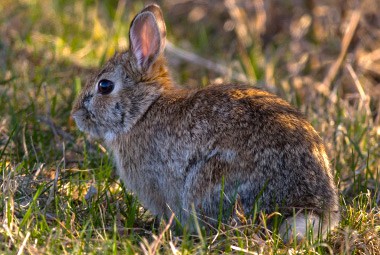
Eastern Cottontail rabbits are lagomorphs, not rodents as many people think. Being a lagomorph means that they have four incisors in their upper jaw and are strictly herbivores. Eastern cottontail rabbits are a prey species and are hunted by humans and fed on by foxes, hawks, owls, and other predatory species.
| Pest Identification | |
|---|---|
| Recognition | Adult Eastern cottontail rabbits can weigh between 2-4 pounds and can grow to be 14-17 inches in length. Their coloring depends on the habitat that they are living in and can range from light brown to dark gray in color. They have long ears that stand up, black feet, and their signature white “fluffy” tail. |
| Biology | Breeding for the Eastern cottontail rabbits generally takes place between February and September; they are polygamous which means that one male will mate with several females. Males and females display courtship behaviors that include running, hoping, and fighting. Females give birth to 4-6 young after a 28-30 day gestation period. Each female typically produces three liters per year. To prepare for the birth the female creates a shallow crater that she lines with grass and fur and then covers over with grass and leaves to hide it. Eastern cottontail rabbits are born blind and hairless; they develop quickly though and will be ready to leave the nest at about 3 weeks of age. They are then ready to breed at about 6 months of age. |
| Habits | Eastern cottontail rabbits are solitary animals and will aggressively defend their territories against each other. Because they are prey species that like to feed in an area that is close to a source of shelter, they live in wooded or covered areas that are located next to open fields, meadows or other spaces These rabbits stay hidden during the day in thick brush, hollow logs, or woodpiles. They will come out to forage for food in the early morning and evening hours. Eastern cottontail rabbits are a pest species that can become problematic for both farmers and homeowners; they feed on and damage crops, flowers, and ornamental landscaping. |
| Prevention | Preventing Eastern cottontail rabbits from choosing your property to live and feed on can be difficult. One of the best ways to stop problems with rabbits is to install mesh wire fences around areas in which you are trying to keep rabbits out. It is important to make sure that the base of the wire is secured to the ground. You can help to prevent rabbits from burrowing underneath of sheds, porches, decks, and garages by installing fences underneath of those areas. It can also be helpful to remove the habitats around your home like woodpiles, brush and other areas that can attract rabbits. |

